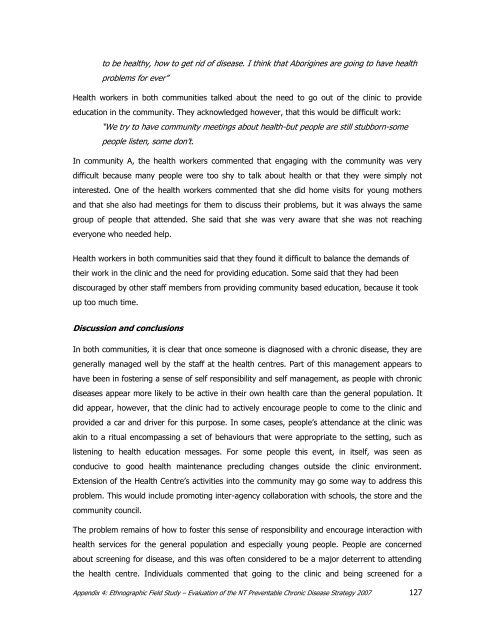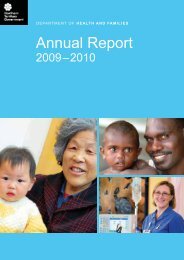PCD Strategy Evaluation 2007.pdf - NT Health Digital Library ...
PCD Strategy Evaluation 2007.pdf - NT Health Digital Library ...
PCD Strategy Evaluation 2007.pdf - NT Health Digital Library ...
You also want an ePaper? Increase the reach of your titles
YUMPU automatically turns print PDFs into web optimized ePapers that Google loves.
to be healthy, how to get rid of disease. I think that Aborigines are going to have healthproblems for ever”<strong>Health</strong> workers in both communities talked about the need to go out of the clinic to provideeducation in the community. They acknowledged however, that this would be difficult work:“We try to have community meetings about health-but people are still stubborn-somepeople listen, some don‟t.In community A, the health workers commented that engaging with the community was verydifficult because many people were too shy to talk about health or that they were simply notinterested. One of the health workers commented that she did home visits for young mothersand that she also had meetings for them to discuss their problems, but it was always the samegroup of people that attended. She said that she was very aware that she was not reachingeveryone who needed help.<strong>Health</strong> workers in both communities said that they found it difficult to balance the demands oftheir work in the clinic and the need for providing education. Some said that they had beendiscouraged by other staff members from providing community based education, because it tookup too much time.Discussion and conclusionsIn both communities, it is clear that once someone is diagnosed with a chronic disease, they aregenerally managed well by the staff at the health centres. Part of this management appears tohave been in fostering a sense of self responsibility and self management, as people with chronicdiseases appear more likely to be active in their own health care than the general population. Itdid appear, however, that the clinic had to actively encourage people to come to the clinic andprovided a car and driver for this purpose. In some cases, people‟s attendance at the clinic wasakin to a ritual encompassing a set of behaviours that were appropriate to the setting, such aslistening to health education messages. For some people this event, in itself, was seen asconducive to good health maintenance precluding changes outside the clinic environment.Extension of the <strong>Health</strong> Centre‟s activities into the community may go some way to address thisproblem. This would include promoting inter-agency collaboration with schools, the store and thecommunity council.The problem remains of how to foster this sense of responsibility and encourage interaction withhealth services for the general population and especially young people. People are concernedabout screening for disease, and this was often considered to be a major deterrent to attendingthe health centre. Individuals commented that going to the clinic and being screened for aAppendix 4: Ethnographic Field Study – <strong>Evaluation</strong> of the <strong>NT</strong> Preventable Chronic Disease <strong>Strategy</strong> 2007 127
















